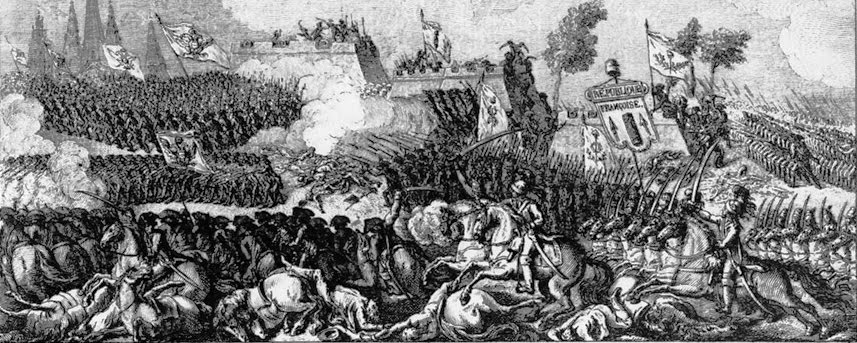In the above, I have stressed that the ordre
profond was not a radically-conceived or under-supported movement. Instead,
deep-order tactics were designed to have practical outcomes for the ancien
régime armies, and gained the support of a wide audience. Yet despite this
support, the ordre profond was not immediately incorporated into the
French tactical canon. Instead, as will now be examined, the idea underwent
decades of debate. Opposition to the ordre profond was not usually
ideologically based, as is sometimes alleged.[1]
Well-versed in military scholarship, tacticians expressed a number of practical
concerns with the ordre profond. [2]
These concerns were widely shared and expressed. Recent scholarship by Sandra
Powers has demonstrated the presence of a wide circle of book-sharing between
European and American military philosophes, including copies and
annotations of authors varied from Polybius to Vegetius, and Folard to
Frederick. A copy of Drummond de Melfort's Traite sur la Cavalerie, for
example, was annotated by and passed between the Duc d’Orleans (advocate of the
ordre profond), Marshal Castries, Montmorency-Laval, Lauzun, Rochambeau,
and George Washington.[3] Consequently, the ordre profond was a
well-known point of contention in France’s academic and military circles, and
was debated on an accordingly large scale.
Even during its infancy, the ordre profond
was reasonably high-profile. Though initially confined to theory, the ordre
profond’s first major proponents, Jean Charles Chevalier
de Folard and Maurice de Saxe, were both extremely influential. Not
only were they major military figures in France during their lifetimes, but
their publications received a great deal of posthumous attention. The system
began with Folard, who published his Nouvelles D' écouvertes sur la guerre dans
une dissertation de Polybe in 1724. In it, Folard proposed a 24-30
man wide by 46 man deep column to be used on the battlefield in every
circumstance.[4] He
suggested that the “manner of fighting by column is . . . superior to all others,” and that
France’s battalions knew “neither how to attack nor defend themselves . . .
because they [fought] on so little depth that they [could] easily be pierced
and broken.” [5]
Claiming that depth would maintain French morale while dashing the enemy lines,
Folard took specifically from Polybius’ doubled phalanx, even claiming to have
improved upon it.[6] He
believed that deep-order formations promoted the ultimate solidarity between
soldiers, and rejected the notion that firearms could or would break troops in
column formation, stating that it was “morally impossible that a column could
ever be broken.” [7] Most,
including Saxe, agreed that Folard went “too far,” particularly in his claim
that “all ground is proper” for the column.[8]
Nevertheless, even Frederick the Great encouraged all his officers to read Folard,
though notably he informed them it contained “diamonds in a dung heap.” [9]
[1] James R Arnold,
“A Reappraisal of the Column versus the Line in the Peninsular War,” The
Journal of Military History 68, no. 2 (April 2004): 537.
[2] Starkey, 212;
Powers, 787-788.
[3] Ibid.,
788; Powers also notes that between 1770-1772, the Encyclopedie Militaire, a
journal devoted to the military debates of the time, was widely popular in
Paris, and devoted particular attention to the works and achievements of
authors and generals such as Saxe, Folard, Montecuccoli, and Frederick. Ibid.,
783.
[6] Folard specifically stated that the column “has
the solidity and the impulsion of the doubled phalanx, of which Polybius
speaks, without having its weaknesses.” Jean-Charles
de Folard, Nouvelles d’ecouvertes sur la guerre dans une dissertation sur
Polybe (Paris: Jean-Francois Josse, 1726), 200.
[7] Folard, quoted in Quimby, 30.
[8] Saxe, Memoires sur L’Art de la Guerre, 3; Folard,
200.

No comments:
Post a Comment